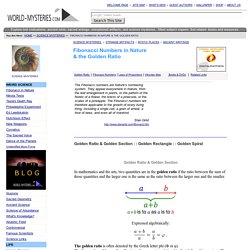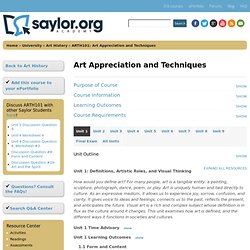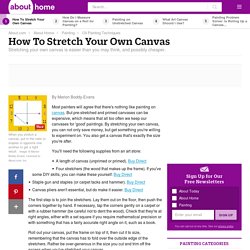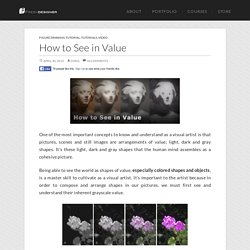

Science Mysteries, Fibonacci Numbers and Golden section in Nature. Golden Ratio & Golden Section : : Golden Rectangle : : Golden Spiral Golden Ratio & Golden Section In mathematics and the arts, two quantities are in the golden ratio if the ratio between the sum of those quantities and the larger one is the same as the ratio between the larger one and the smaller.

Expressed algebraically: The golden ratio is often denoted by the Greek letter phi (Φ or φ). The figure of a golden section illustrates the geometric relationship that defines this constant. Golden Rectangle A golden rectangle is a rectangle whose side lengths are in the golden ratio, 1: j (one-to-phi), that is, 1 : or approximately 1:1.618. Golden Spiral In geometry, a golden spiral is a logarithmic spiral whose growth factor b is related to j, the golden ratio. Successive points dividing a golden rectangle into squares lie on a logarithmic spiral which is sometimes known as the golden spiral. Golden Ratio in Architecture and Art Here are few examples: Parthenon, Acropolis, Athens. Character Design References on Pinterest.
Lackadaisy Expressions. Boy, I didn't know what I was getting myself into when I started this.

I've had requests for some sort of expressions tutorial dating back a while now, so I figured, "Sure! I can explain expression drawing...and it'll be way better than all those tutorials out there that are nothing but charts of generic expressions. Yeah! Just give me a day or two to whip something up... " Um. Anyway, I found all I could really do was try to explain ways to teach yourself...and then add some pictures. ARTH101: Art Appreciation and Techniques.
This course is an exploration of visual art forms and their cultural connections for the student with little experience in the visual arts.

It includes a brief study of art history, and in-depth studies of the elements, media, and methods used in creative thought and processes. In this course, you will learn how to develop a five-step system for understanding visual art in all forms, based on the following: Description: A work of art from an objective point of view – its physical attributes, and formal construction.Analysis: A detailed look at a work of art that combines physical attributes with subjective statements based on the viewer’s reaction to the work.Context: Historical, religious, or environmental information that surrounds a particular work of art and which helps to understand the work’s meaning.Meaning: A statement of the work’s content. Welcome to ART101: Art Appreciation and Techniques. General information on this course and its requirements can be found below. How To Stretch Your Own Canvas. By Marion Boddy-Evans Most painters will agree that there's nothing like painting on canvas.

But pre-stretched and primed canvases can be expensive, which means that all too often we keep our canvases for 'good' paintings. By stretching your own canvas, you can not only save money, but get something you're willing to experiment on. You also get a canvas that's exactly the size you're after. You'll need the following supplies from an art store: A length of canvas (unprimed or primed). The first step is to join the stretchers. Roll out your canvas, put the frame on top of it, then cut it to size, remembering that the canvas has to fold over the outside edge of the stretchers. Stretch Canvas with Logic, Not Randomly. How to See in Value - Freshdesigner.com. One of the most important concepts to know and understand as a visual artist is that pictures, scenes and still images are arrangements of value; light, dark and gray shapes.

It’s these light, dark and gray shapes that the human mind assembles as a cohesive picture. Being able to see the world as shapes of value, especially colored shapes and objects, is a master skill to cultivate as a visual artist. It’s important to the artist because in order to compose and arrange shapes in our pictures, we must first see and understand their inherent grayscale value.
The most basic and abstract pattern of dark and light shapes (A) is the first ‘read’ the mind makes. This happens on a visceral, almost subconscious level. How do we train our eyes to see the world in value? To see these strategies in action, watch the video below or continue reading for the in-depth breakdown. Step 1: Ignore color information One way to see color as value is to simply ignore the color.
Step 2: Look for Edges and Borders. Untitled. Golden Artist Colors, Inc.